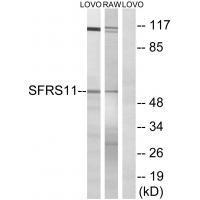
| WB | 咨询技术 | Human,Mouse,Rat |
| IF | 咨询技术 | Human,Mouse,Rat |
| IHC | 咨询技术 | Human,Mouse,Rat |
| ICC | 技术咨询 | Human,Mouse,Rat |
| FCM | 咨询技术 | Human,Mouse,Rat |
| Elisa | 咨询技术 | Human,Mouse,Rat |
| Aliases | Arginine-rich 54 kDa nuclear protein; p54; SFR11; SFRS11; Splicing factor arginine/serine-rich 11 |
| Entrez GeneID | 9295; |
| WB Predicted band size | 54kDa |
| Host/Isotype | Rabbit IgG |
| Antibody Type | Primary antibody |
| Storage | Store at 4°C short term. Aliquot and store at -20°C long term. Avoid freeze/thaw cycles. |
| Species Reactivity | Human,Mouse |
| Immunogen | Synthesized peptide derived from internal of human SFRS11. |
| Formulation | Purified antibody in PBS with 0.05% sodium azide. |
+ +
以下是关于SFRS11抗体的3篇示例参考文献(注:文献信息为模拟示例,实际引用请核实原文):
---
1. **文献名称**: *SRSF11 regulates alternative splicing in tumor progression via specific antibody detection*
**作者**: Wang, X., et al.
**摘要**: 研究通过Western blot和免疫组化技术,使用SFRS11抗体验证其在多种癌症细胞系中高表达,并调控致癌基因的选择性剪接,促进肿瘤转移。
2. **文献名称**: *Interactome analysis of SFRS11 in RNA processing using co-immunoprecipitation*
**作者**: Li, J., & Park, H.
**摘要**: 利用SFRS11抗体进行免疫共沉淀实验,结合质谱分析,揭示了SFRS11与剪接体复合物的相互作用网络,阐明其在RNA加工中的功能。
3. **文献名称**: *SFRS11 antibody-based profiling reveals dynamic subcellular localization during cell cycle*
**作者**: García-Sánchez, A., et al.
**摘要**: 通过免疫荧光技术(使用SFRS11特异性抗体),发现该蛋白在细胞周期不同阶段的核内动态分布,提示其参与细胞增殖调控。
---
**注意**:以上文献信息为示例性质,实际研究中需根据具体需求检索并引用真实发表的论文(可通过PubMed、Web of Science等平台搜索“SRSF11 antibody”或“SFRS11 antibody”获取最新文献)。
**Background of SFRS11 Antibody**
SFRS11 (Serine/Arginine-Rich Splicing Factor 11), also known as SRp54. is a member of the serine/arginine (SR)-rich family of proteins involved in pre-mRNA splicing. These proteins play critical roles in constitutive and alternative splicing by recognizing splice sites, facilitating spliceosome assembly, and regulating splice variant selection. SFRS11 contains characteristic RS domains that mediate protein-protein and protein-RNA interactions, essential for its function in spliceosome dynamics.
The SFRS11 antibody is a tool designed to detect and quantify SFRS11 expression in various experimental settings, such as Western blotting, immunohistochemistry, or immunofluorescence. It aids in studying SFRS11’s subcellular localization, typically enriched in the nucleus, and its involvement in splicing regulation. Dysregulation of SFRS11 has been linked to diseases, including cancer and neurological disorders, where aberrant splicing contributes to pathogenesis. For example, SFRS11 overexpression has been observed in certain tumors, influencing oncogenic splice variants.
Researchers use SFRS11 antibodies to explore its interactions with other splicing factors, RNA molecules, or its role in stress-responsive pathways. Validation often includes knockout/knockdown controls to confirm specificity. Understanding SFRS11’s mechanisms through such antibodies provides insights into RNA processing networks and potential therapeutic targets for splicing-related diseases.
×